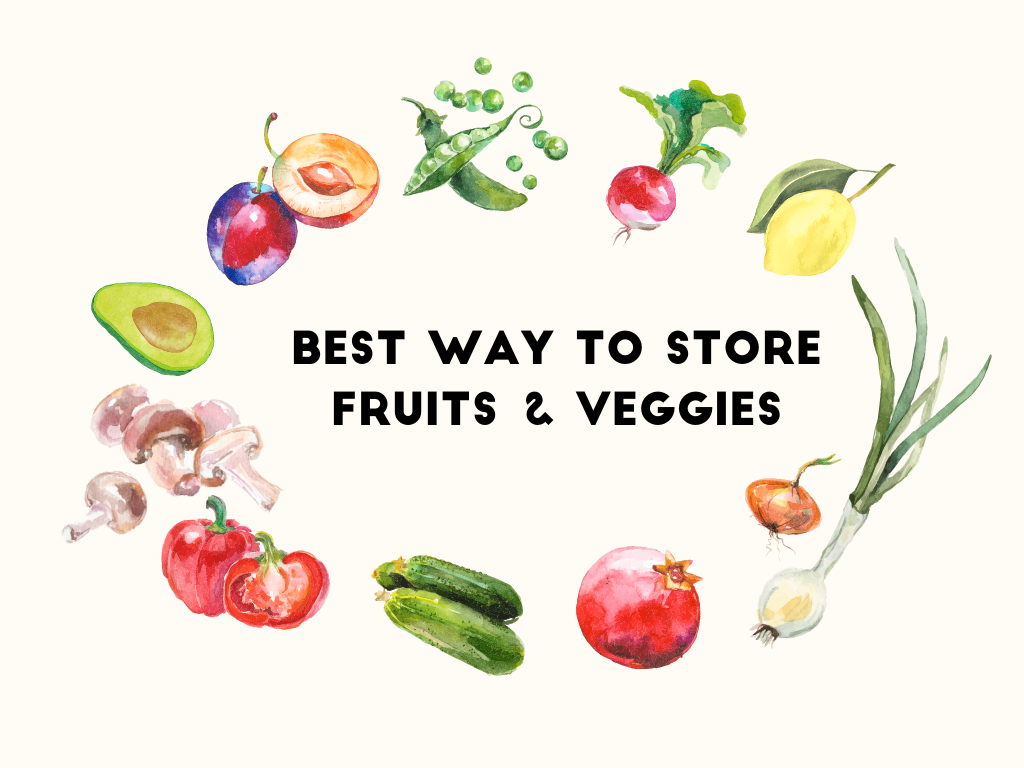A CSA Member's Guide to Storing Fruits and Veggies
We believe that all the best things are meant to be shared! That includes the contents of your CSA box.
While we work to provide diverse fruits & veggies, we want to make sure that our members are getting the most from their CSA box. Here are some helpful ways to keeping your produce fresh:
Proper food storage is easiest to remember when you keep 3 things in mind: Moisture, Temperature, and Isolation. Washing vegetables before storing shortens their life. It may also contribute to mold. That said, the carrots you receive in your share have been prewashed for better inspected prior to packing. Carrots and radishes do well with moisture, while spinach and strawberries do not. Temperature is also important to be aware of. Maintaining a consistent and precise temperature is key to keeping fruits and vegetables fresh. The standard temperature that we feel is adequate for fresh vegetables, as well as food safety is between 35℉-38℉. For the freezer, anything below freezing, 0℉, will do the trick. Since certain vegetables and fruits release more ethylene, a chemical that allows them to ripen, it is important to keep them isolated from each other. A general rule of thumb is to keep vegetables and fruits in different storage compartments in the fridge.
Leafy Greens
Swiss Chard + Kale + Spinach +Fresh Herbs
For leafy greens to retain their crispness and flavor, wrap leaves with a paper towel and store, unwashed, in a plastic bag in the crisper bin of the refrigerator. Greens will last 3-5 days.
Roots
Beets + Carrots+ Parsnips + Radish + Turnips
Roots can be stored up to 10 days in the crisper drawer. Simply cut the leafy green tops and store them separately in a plastic bag or airtight container. The green tops can be used in sautees, soups, or pestos within 3 days.
Dry & Fresh Alliums
Fresh: Leeks + Green Garlic +Green Onions + Scallions + Spring Onions + Spring Shallots
Dry: Garlic + Onions + Shallots
While dried onions can be stored in the cupboard away from sunlight, fresh alliums should be stored in a plastic bag in the refrigerator. Keep storage away from light and use within 2 weeks' time. Fresh onions should be used within 1 week.
Winter Squash
Acorn + Butternut + Delicata + Honeynut + Kabocha
Distinguished by their harder skins, winter squash can be stored for a long time. Store winter squash in a cool, dry place away from sunlight up to 2 to 3 weeks.
Summer Squash
Crookneck + Scallop + Zucchini
Since summer squash has delicate skin that is thinner than winter squash, it should be stored in the crisper drawer of the refrigerator. It is best to keep moisture away from summer squash. We suggest storing them unwashed, whole, and as dry ask possible. Wrap them with a paper towel and placing them in a plastic bag. Use squash within 1 week.
Brassicas
Broccoli + Brussel Sprouts + Cauliflower + Romanesco
Since there are many airy parts to this vegetable, it is best to keep it as dry as possible to prevent mold from forming. Store unwashed in an open or perforated plastic bag and use within 1 week.
Peppers
Anaheim + Bells + Jalapeno + Gypsy +Shishitos
Peppers have waxy skin making them pretty easy to store. Simply place unwashed peppers in the crisper drawer and use them within 5 days. For longer storage time place peppers in a plastic bag in the refrigerator.
Tomatoes
Tomatoes are best stored in a paper bag on the counter. By keeping them away from sunlight, the paper bag will delay over-ripening and absorb moister. Tomatoes become mealy in the fridge, so we recommend keeping them on the counter as long as you can and place them in the refrigerator once they are at their peak ripeness. Tomatoes can be stored up to 1 week at room temperature
Mushrooms
The best way to store mushrooms is unwashed in a paper bag in the refrigerator. They should be used within a week to maintain optimal nutrition and texture. Mushrooms can also be stored slightly cooked and added to dished throughout the week.
Potatoes
Like tomatoes, keep potatoes away from light as it will promote them to produce spored. When stored between 43-50℉, potatoes will keep for months without spoiling. Storing potatoes at cooler temperatures also preserves their vitamin C content. Storing potatoes in slightly warmer temperatures will shorten their shelf life. Potatoes can be stored in the crisper bin of the refrigerator up to 1 month.
Stone Fruits
Apricots + Peaches+ Plums
Stone fruits should be ripened on the counter then moved to the crisper drawer of the refrigerator. Keep stone fruits uncovered at room temperature on the counter for two days. Press the top of your finger softly near the stem of the fruit. If it dents easily, it is ripe. Store in the refrigerator for 3 to 5 days.
Berries
Blackberries + Blueberries + Cherries + Strawberries
Berries carry mold spores that cause them to go bad very quickly; spreading through the whole basket! You can easily kill off the mold with a quick lemon juice and water bath. Spread the berries on a towel and let them dry completely. Store berries in an airtight container with a paper towel. The rinsed berries should stay fresh for 5 - 7 days.
Citrus
Grapefruit + Kumquats + Lemon + Orange
Citrus fruits prefer to be stored at cool temperatures. It is important the there is enough air and space around the fruit to prevent spoilage. To make sure there is plenty of air circulation around it, place fruits, uncrowded, in a fruit basket. If you have a bounty of citrus, store what you will eat within a few days on the countertop, and the rest in the refrigerator.
















